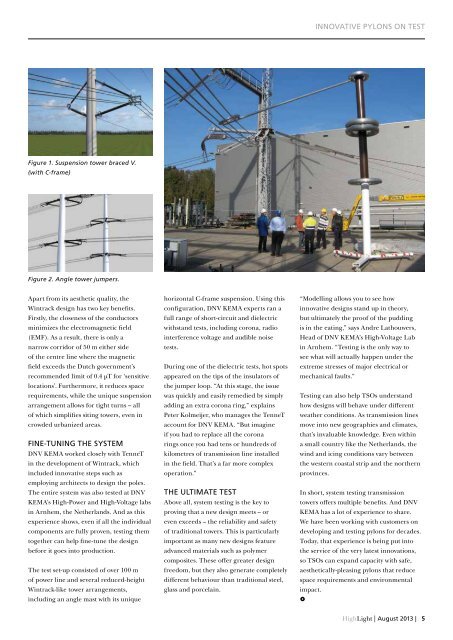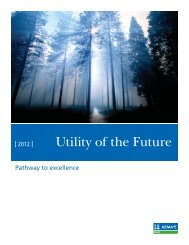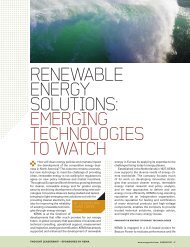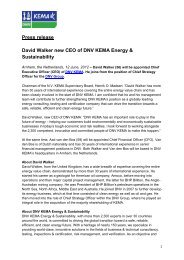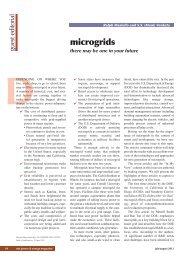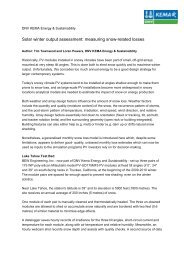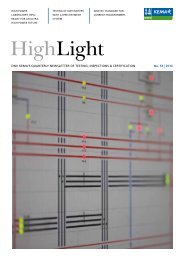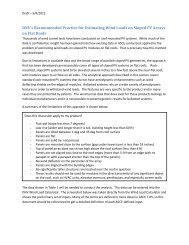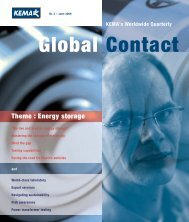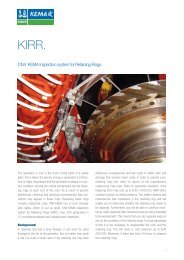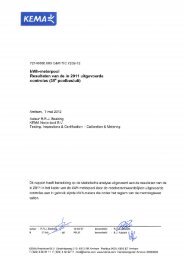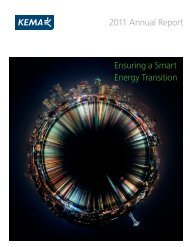HighLight 55 - DNV Kema
HighLight 55 - DNV Kema
HighLight 55 - DNV Kema
Create successful ePaper yourself
Turn your PDF publications into a flip-book with our unique Google optimized e-Paper software.
Innovative pylons on test<br />
Figure 1. Suspension tower braced V.<br />
(with C-frame)<br />
Figure 2. Angle tower jumpers.<br />
Apart from its aesthetic quality, the<br />
Wintrack design has two key benefits.<br />
Firstly, the closeness of the conductors<br />
minimizes the electromagnetic field<br />
(EMF). As a result, there is only a<br />
narrow corridor of 50 m either side<br />
of the centre line where the magnetic<br />
field exceeds the Dutch government’s<br />
recommended limit of 0.4 µT for ‘sensitive<br />
locations’. Furthermore, it reduces space<br />
requirements, while the unique suspension<br />
arrangement allows for tight turns – all<br />
of which simplifies siting towers, even in<br />
crowded urbanized areas.<br />
Fine-tuning the system<br />
<strong>DNV</strong> KEMA worked closely with TenneT<br />
in the development of Wintrack, which<br />
included innovative steps such as<br />
employing architects to design the poles.<br />
The entire system was also tested at <strong>DNV</strong><br />
KEMA’s High-Power and High-Voltage labs<br />
in Arnhem, the Netherlands. And as this<br />
experience shows, even if all the individual<br />
components are fully proven, testing them<br />
together can help fine-tune the design<br />
before it goes into production.<br />
The test set-up consisted of over 100 m<br />
of power line and several reduced-height<br />
Wintrack-like tower arrangements,<br />
including an angle mast with its unique<br />
horizontal C-frame suspension. Using this<br />
configuration, <strong>DNV</strong> KEMA experts ran a<br />
full range of short-circuit and dielectric<br />
withstand tests, including corona, radio<br />
interference voltage and audible noise<br />
tests.<br />
During one of the dielectric tests, hot spots<br />
appeared on the tips of the insulators of<br />
the jumper loop. “At this stage, the issue<br />
was quickly and easily remedied by simply<br />
adding an extra corona ring,” explains<br />
Peter Kolmeijer, who manages the TenneT<br />
account for <strong>DNV</strong> KEMA. “But imagine<br />
if you had to replace all the corona<br />
rings once you had tens or hundreds of<br />
kilometres of transmission line installed<br />
in the field. That’s a far more complex<br />
operation.”<br />
The ultimate test<br />
Above all, system testing is the key to<br />
proving that a new design meets – or<br />
even exceeds – the reliability and safety<br />
of traditional towers. This is particularly<br />
important as many new designs feature<br />
advanced materials such as polymer<br />
composites. These offer greater design<br />
freedom, but they also generate completely<br />
different behaviour than traditional steel,<br />
glass and porcelain.<br />
“Modelling allows you to see how<br />
innovative designs stand up in theory,<br />
but ultimately the proof of the pudding<br />
is in the eating,” says Andre Lathouwers,<br />
Head of <strong>DNV</strong> KEMA’s High-Voltage Lab<br />
in Arnhem. “Testing is the only way to<br />
see what will actually happen under the<br />
extreme stresses of major electrical or<br />
mechanical faults.”<br />
Testing can also help TSOs understand<br />
how designs will behave under different<br />
weather conditions. As transmission lines<br />
move into new geographies and climates,<br />
that’s invaluable knowledge. Even within<br />
a small country like the Netherlands, the<br />
wind and icing conditions vary between<br />
the western coastal strip and the northern<br />
provinces.<br />
In short, system testing transmission<br />
towers offers multiple benefits. And <strong>DNV</strong><br />
KEMA has a lot of experience to share.<br />
We have been working with customers on<br />
developing and testing pylons for decades.<br />
Today, that experience is being put into<br />
the service of the very latest innovations,<br />
so TSOs can expand capacity with safe,<br />
aesthetically-pleasing pylons that reduce<br />
space requirements and environmental<br />
impact.<br />
<br />
<strong>HighLight</strong> | August 2013 | 5


